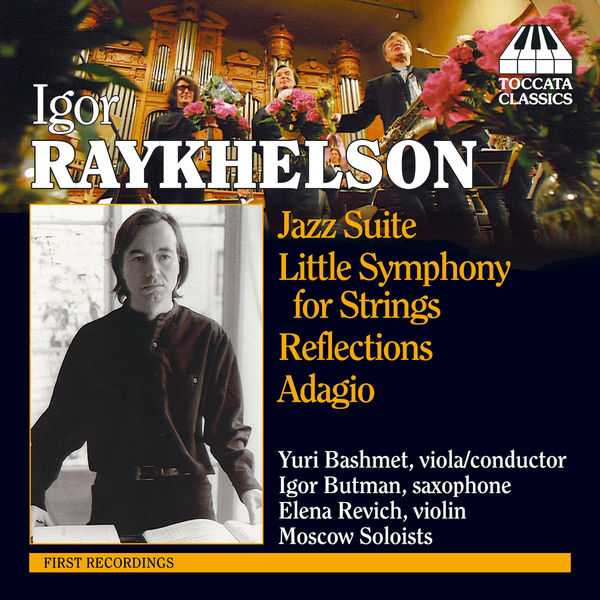
Composer: Igor Raykhelson
Performer: Igor Butman, Elena Revich, Yuri Bashmet
Orchestra: Moscow Soloists
Conductor: Yuri Bashmet
Format: FLAC (tracks)
Label: Toccata
Catalogue: TOCC0055
Release: 2007
Size: 318 MB
Recovery: +3%
Scan: cover
Little Symphony in G Minor
01. I. Alla Waltz
02. II. Scherzando
03. III. Adagio
04. IV. Allegro
05. Reflections
06. Adagio
Jazz Suite
07. I. Theme
08. II. Fusion
09. III. Jazz Waltz, “Take Three”
10. IV. Fugue
11. V. Swing
12. VI. Consolation
13. VII. Finale
In the words of his friend the violist and conductor Yuri Bashmet, the composer-pianist Igor Raykhelson – born in Leningrad in 1961 and now resident in New York – ‘possesses a superb mastery of both classical and jazz idioms’. The highly individual fusion of styles that results, Bashmet continues, ‘elevates his music over that of many other composers creating in the genre often referred to as “crossover”’. The Jazz Suite on this CD exhibits Raykhelson’s popular style at its most infectiously catchy; the other three works here – in the Russian tradition of writing for strings initiated by Tchaikovsky – present the more classical side of his muse.
Composer Igor Raykhelson had his early training in what was then the Soviet Union and later lived in New York and studied jazz piano. This CD is offered as a sampler of his compositional style. In his music for strings he follows the Shostakovich idiom popular among a number of Russian composers, straight down to the ponderous slow movement of the Little Symphony for strings in G minor; several of the pieces were written for violist and conductor Yuri Bashmet, who has exploited the popularity of the Shostakovich style. Raykhelson has not been the only Russian composer to draw on jazz, either; jazz had a long tradition in the Soviet Union (where it was, to borrow the title of a study on the subject, “red and hot”). His contribution to this repertoire, however, is unique, and after hearing this disc one suspects this is where his talent lies. Annotator Arkady Petrov evokes the name of Gershwin in his notes, but Raykhelson’s Jazz Suite for viola, saxophone, and orchestra really resembles neither Gershwin’s attempt at a symphonic extension of the language of jazz nor the attempts of composers starting with Stravinsky and Ravel to incorporate jazz rhythms into their own compositional conceptions. One might argue that Raykhelson has started from a position of respect for the problem of combining two musics that, despite certain meeting points, fundamentally differ in their organizational principles. He does not try to merge jazz and twentieth century chamber music but has them glance off one another and, at times, blend into one another at the edges. The seven movements of his suite mostly contain shorter individual sections rhythmically associated with either jazz or concert music, and the interest of the music evolves as the methods of getting from one to the other expand in range. Igor Butman’s saxophone is key to this process; the sax is, naturally, primarily associated with jazz passages, but it also serves various transitional functions. The finale is in the nature of a container in which the elements are mixed together more thoroughly than they have been up to that point, with Bashmet’s viola emerging into a full-fledged jazz role as if to say that some kind of reconciliation of the two musics has been achieved. (His jazz solos were notated by Raykhelson, but the rest of the jazz is improvised.) The Jazz Suite offers evidence that the so-called third stream has not run dry, and anyone interested in the broader question of the place of concert music in a vernacular musical world should hear it.